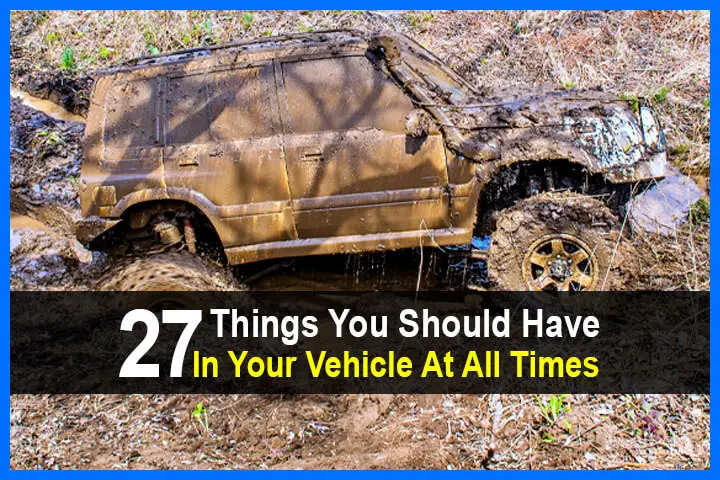Estimated reading time: 9 minutes
If you didn’t already understand the importance of preparedness, the COVID-19 situation should have taught you. In 2019, would anyone have predicted that we would be facing a massive pandemic?
The same logic goes for when you’re driving. You never know when something bad may happen. What if you’re stranded in the middle of nowhere due to engine failure? What if the grid collapses and chaos envelops your neighborhood while you’re away from home?
This is why you need to always be prepared, and part of this preparation means having emergency items in your car. But which specific items should you have in your car at all times? That’s what we’re going to talk about today.
Want to save this post for later? Click Here to Pin It On Pinterest!
1. Backpack
Keep most of the items on this list in a backpack so you can evacuate your vehicle with everything if you need to. Make sure your backpack is well made, rugged, has comfortable and adjustable straps, and has neutral colors that will help you blend in and not stand out.
2. Blanket
Keep two blankets in your car at all times. The best one to get will be wool blankets or reflective heat blankets. Both will work well at keeping you warm. Avoid cotton blankets because they do a very poor job of resisting water.
Make sure that both blankets can pack down nice and compact so you can stash one or both away in your backpack if you need to bug out from the car.
3. Cash
Keep at least $100 in cash in your car at all times. This should be divided up into $20, $10, $5, and $1 bills. Keep the cash in a Ziploc bag for convenience and to help create some barrier in between it and the outside elements.
4. Cat Litter
For winter survival situations, you can spread cat litter on ice to make it easier for you to walk over.
5. Clothes (Extra)
Always keep an extra change of clothes in your car. Have one pair of hiking boots or shoes (you don’t want to evacuate your vehicle in sandals or flip flops), an extra pair of cargo pants or jeans, an extra shirt, a jacket, extra pair of socks, and gloves.
6. Duct Tape
The versatility of duct tape is unmatched for temporary repairs on everything from torn clothing to cracked windows. A roll of duct tape can be a critical tool in your vehicle’s emergency kit for both minor inconveniences and serious situations.
7. Emergency Radio
Staying informed is crucial in any emergency. A good emergency radio can provide access to weather alerts and emergency broadcasts without relying on batteries or electricity. Look for a model that includes NOAA weather channels and is small enough to fit in your backpack.
8. Fire Starting Devices
Plan on having at least three different fire-starting devices in your car at all times – matches, a magnesium flint striker, and a lighter will represent your best bets.
While you’re at it, include items that are easily flammable so you can get a fire going quickly. Cotton balls soaked in Vaseline or fire sticks are good options here.
9. First Aid Kit
Always keep a complete first aid kit in your car, and keep it separated in its own pack for ease of organization and transportation. This pack could then fit inside your backpack if you needed it to. Make sure to fully familiarize yourself with the inside of your first aid kit so you know all of its contents.
For this reason, it may be wise to buy all of the components separately and make your first aid kit truly customizable. It’s one way to make sure that you know everything that is included in the kit.
10. Flag (Red or Orange)
A brightly colored red or orange flag can be tied to the outside of an immovable vehicle during a winter snowstorm. This way, you should be visible to other cars coming by so you can hopefully be rescued.
11. Flares
Flares can also be used for signaling for help, such as if your vehicle becomes stranded, and from much farther distances than a red flag can. Have at least three in your car.
12. Flashlight
Always keep a good flashlight with an extra set of batteries in your car. This will make it easier to inspect your vehicle or to leave the car at night or in darkness if you have to. The best kind of flashlight to keep in your vehicle will have a powerful LED beam, but will also be small and compact so it can be easily carried around.
13. Food
Keep enough food in your car to help you survive for at least three days. You need food that is small, portable, long-lasting, and come packed with nutrition.
Simple protein bars or energy bars would fill this bill nicely, but nothing too chocolatey or it will melt. You can also include MRE’s or similar food items where all you need is water and some heat to cook them up.
14. GPS Device
Keep a GPS device in your car with spare batteries. This can help you to navigate while you drive, and to navigate if you are forced to leave your car and bug out on foot.
15. Gun
This one is optional. Some people are uncomfortable at the thought of keeping a firearm in their car under the fear that someone may break into their vehicle and steal it. It has happened before.
The best solution is to keep your firearm secured, such as in a car safe in between the seat and center console or underneath the driver’s seat. Just make sure that the firearm is easily accessible so you can defend yourself from the driver’s seat if need be. Have extra ammunition as well.
16. Knife
Keep two knives in your car at all times – a fixed blade knife and a folding blade knife that you can keep clipped to the inside of your pocket. If you already keep a knife clipped in your pocket, it doesn’t hurt to have backups.
The fixed blade knife will be used for more heavy-duty tasks such as defense or shelter building or splitting wood, while the folding knife will be used for more precise work.
17. Jumper Cables
Even people who don’t keep a survival kit in their vehicle will usually at least understand the importance of keeping jumper cables in their car. If you don’t have jumper cables in your vehicle yet, change that.
18. Map and Compass
While smartphones have largely replaced traditional navigation tools, technology can fail, especially in remote areas. Keeping a detailed map and a compass in your vehicle ensures you won’t get lost, even if your phone dies. Familiarize yourself with basic map-reading and orienteering skills to enhance your preparedness.
19. Medical Mask
This would probably be wise to include just because of the current COVID-19 situation. Aside from that, a medical mask can also keep particles such as dust out of your mouth and nostrils too. As an alternative option, you could also go with a well-made bandana.
20. Multi-Tool
Multi-tools are an easy way to bring a variety of tools along without taking up much space. Look for one that includes pliers, a knife, screwdrivers, and a can opener. A good multi-tool can be great in situations where you need to repair or adjust something, or when you need to cut, twist, or pry something open.
21. Paracord
Paracord truly is one of the most versatile survival items ever invented. Keep at least one to two hundred feet in your car at all times. You can use it for shelter building, rappelling down a steep edge, making fishing line or a clothesline, or in the worst-case scenarios, for tying somebody up.
22. Personal Hygiene Kit
This is one of the most overlooked survival items to have in general, but it’s important (especially if you get stranded many miles away from the nearest town or city).
A complete personal hygiene kit has everything from hand sanitizer to soap to toothpaste to toothbrushes to a mirror and so on. It’s important to keep yourself clean.
23. Prescription Medications
Keep at least a three days’ supply of prescription medications in your car at all times too – especially if you really on these medications to stay alive or in good health.
24. Shovel
A shovel will prove its worth to you on more than one occasion. You can dig trenches and latrines, use it for defense, or just dig holes as needed.
A full-size shovel should work for the back of a pickup truck. For a sedan or SUV, however, you can go with a smaller foldable camping shovel that will be much smaller and more portable.
25. Solar Charger
Nowadays, keeping your phone charged is crucial, especially in emergencies. A portable solar charger ensures that you can recharge your phone and any other devices without needing an outlet or fresh batteries. Be sure to get one that’s durable, water-resistant, and capable of charging multiple devices at once.
26. Toilet Supplies
Include a portable toilet or a bucket with a tight-sealing lid, along with biodegradable bags, toilet paper, and hand sanitizer. Being stranded or in a situation without access to restrooms can be uncomfortable at best and a health hazard at worst. An emergency car toilet will help you maintain hygiene and comfort when nature calls.
27. Water
Keep enough water in your car to survive for a minimum of three days. Preferably, keep it in a metal water canteen rather than plastic containers. This way, your canteen can be used for boiling water over a fire should you run out. It’s also more durable and will resist puncture hits much better.
While you’re at it, also include a water filtration device (such as a Lifestraw) and water purification tablets so you can make water you find safe to drink as well.
Conclusion
The above items belong in any vehicle, regardless of whether it’s a truck, SUV, van, or a sedan. Of course, feel free to add or subtract items based on how you see fit and on your circumstances and environment. Your end goal should be to have the very best car survival kit that you can get.
Like this post? Don’t Forget to Pin It On Pinterest!


















